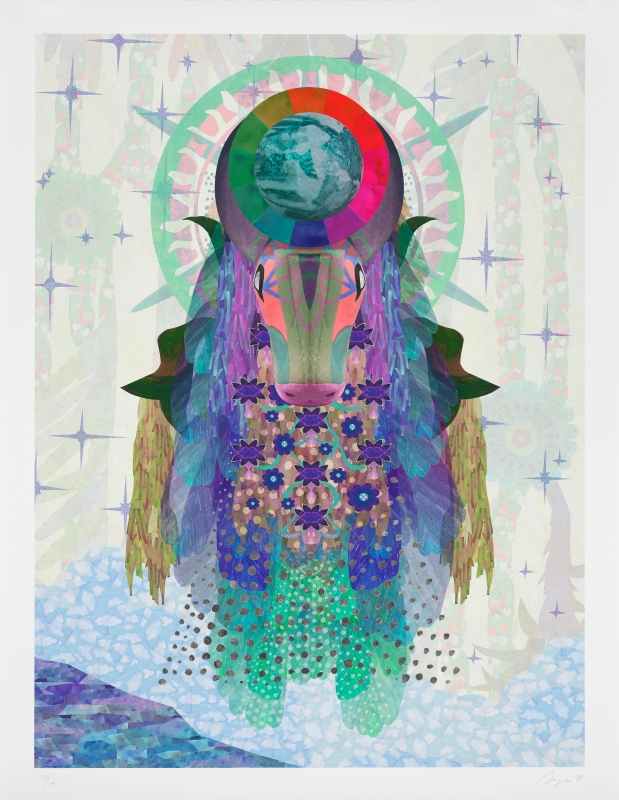“Embody,” the Mandeville Gallery’s fall exhibit, features 10 contemporary artists of diaspora who use collage-making concepts and methods to construct identity through a wide range of representations of the body.
“These figures embody resistance, defying and challenging a one-dimensional reading of who the figure might be or what they represent,” says Julie Lohnes, director and curator of Art Collections and Exhibitions.
The show runs through Jan. 19.
There will be a reception in the Nott Memorial with a performance by exhibiting artist aricoco Tuesday, Sept. 24, 5-6:30 p.m.
In addition, Simonette Quamina will give an artist talk on Tuesday, Oct. 8, 5- 6:30 p.m., also at the Nott.
Both events are free and open to the public.
Born and raised in Tokyo, aricoco (Ari Tabei) lives in New York City. She creates collages with fabric and assorted embellishments to construct garments she dons for performance art that explores the non-hierarchical system of social insects. She has been awarded numerous residencies and fellowships, including a New York Foundation for the Arts Artist’s Fellowship in interdisciplinary work.
Quamina is a native of Canada who grew up in South America, the Caribbean and New York City. She weaves her diverse background into the narratives of her large-scale drawings, prints and collages. Her work is exhibited and collected nationally and internationally, and she has received numerous residencies and fellowships. She lives in New York and is an assistant professor of printmaking at the Eastern Connecticut State University.
The other featured artists are:
Firelei Báez: New York City-based Báez is concerned with the politics of place and heritage, which can be traced to her upbringing on the border between the Dominican Republic and Haiti. Her featured painting, titled “given the ground (the fact that it amazes me does not mean I relinquish it),” is on loan from Trustee Kelly Williams ’86. Her monumental outdoor sculpture, 19.604692°N 72.218596°W, is in the 2019 High Line Art exhibition in New York, while her commission for the Modern Window at the Museum of Modern Art is on view through November.
Amir H. Fallah: Tehran native Fallah is best known for unconventional collaged portraits that explore identity through his subjects’ interactions with objects, while his installations further construct personal narratives about eccentric individuals and influential artists. He lives in Los Angeles and exhibits internationally.
Chitra Ganesh: The daughter of Indian immigrant parents, Ganesh uses history, literature and mythology to connect with problems shaping 21st-century life, from environmental disaster to geopolitical conflicts. Her works in various media are held in the Museum of Modern Art, Whitney Museum of American Art, Philadelphia Museum of Art and San Jose Museum. She is the recipient of a John Simon Guggenheim Memorial Foundation Fellowship in the Creative Arts, Pollock Krasner Foundation Grant and Joan Mitchell Foundation Grant. She has held fellowships at Princeton, Yale University Law School, the Rhode Island School of Design, NYU and the U.S. Art in Embassies Program at NIROX in South Africa.
Toyin Ojih Odutola: Nigerian-born Odutola’s multimedia drawings focus on the sociopolitical construct of skin color as she explores her personal journey of assimilation into American culture in conservative Alabama. Now New York City-based, she has had solo exhibitions at the Whitney and other prominent museums. Her work is included in the Museum of Modern Art in New York, the Museum of African Art at the Smithsonian, and the Baltimore, Philadelphia and Honolulu art museums.
Stacey Robinson: Originally from Albany, N.Y., Robinson was the featured artist in the Art Installation Series in the Schaffer Library Learning Commons in 2017-2018. His multimedia work includes digital collage print on paper. He discusses ideas of “black utopias” as decolonized spaces of peace by considering black affluent, self-sustaining communities, black protest movements and the art that documented them. Robinson is an assistant professor of graphic design at the University of Illinois and an Arthur Schomburg fellow.
David Shrobe: Shrobe’s painterly approach cobbles together found furniture and historical indicators referencing power and wealth of the ruling classes. A native of New York City, he is a frequent exhibitor at galleries there, and his works are in the collections of the Brooklyn Museum of Art, the Walton Family Private Collection and the Jordan Schnitzer Museum of Art at University of Oregon. He is a Joan Mitchell Artist Teaching Fellow.
Didier William: William is a native of Port-au-Prince, Haiti, whose paintings draw upon memory, oratory and historical archives to reimagine narratives of the black diaspora. He has exhibited at museums and galleries in the U.S. and abroad. He is a 2018 recipient of the Rosenthal Family Foundation Award in Art from the American Academy of Arts and Letters. He was featured in the 2017 group show “Accordion Space” in the Feigenbaum Center for Visual Arts. He teaches at Rutgers University and chairs the M.F.A. Program at the Pennsylvania Academy of Fine Arts.
Saya Woolfalk: Based in New York, Woolfalk is a self-described “bi-national” who was born in Gifu City, Japan, to a Japanese mother and a mixed-race African American and white father. She uses science fiction and fantasy to re-imagine the world in multiple dimensions, including the creation of a fictional race of women who are able to alter their genetic makeup and fuse with plants. She is the recipient of many honors, including a Fulbright grant to study in Brazil and a residency at the Studio Museum in Harlem.
Several programs, departments and offices have contributed additional funding for “Embody,” including Africana Studies; Asian Studies; Gender, Sexuality and Women’s Studies; Interdisciplinary Studies; Latin American and Caribbean Studies; Visual Arts; and Multicultural Affairs.
